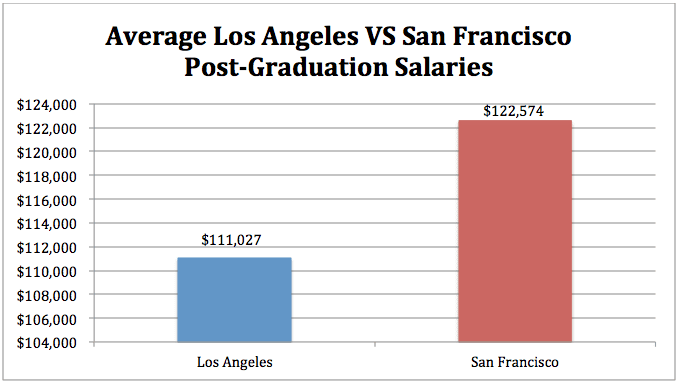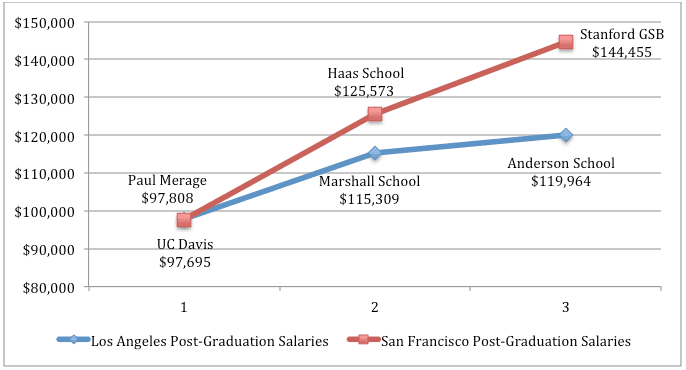LeBronomics: UCLA Professor Explains What to Expect in Los Angeles
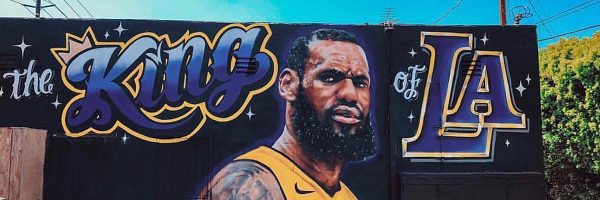
When basketball ultra-star LeBron James inked his new deal with the Los Angeles Lakers, it was more than just a big move for him and fans: it was a big move for the Los Angeles economy. That’s because a star such as James can create a significant financial imprint in any city he plays, according to a study co-authored by Harvard University Associate Professor Daniel Shoag and Stan Veuger of the American Enterprise Institute.
The LeBron James Effect
“James has a statistically and economically significant positive effect on both the number of restaurants and other eating and drinking establishments near the stadium where he is based, and on aggregate employment at those establishments,” the study explains. “Specifically, his presence increases the number of such establishments within one mile of the stadium by about 13 percent, and employment by about 23.5 percent.”
It’s easy to see the difference that James’ presence can make when you take a look at the course of his career. He spent the first seven years in Cleveland, left for Miami for four years, and then returned to Cleveland in 2014, and there’s a definitive impact to the economy each time. Specifically, the effects were felt most strongly within one mile of the arena, but even within seven miles, a difference was still obvious.
As a quick example, the study put together two charts showing the number of restaurants within a one-mile radius of the stadium in both Miami and Cleveland during his presence and without.
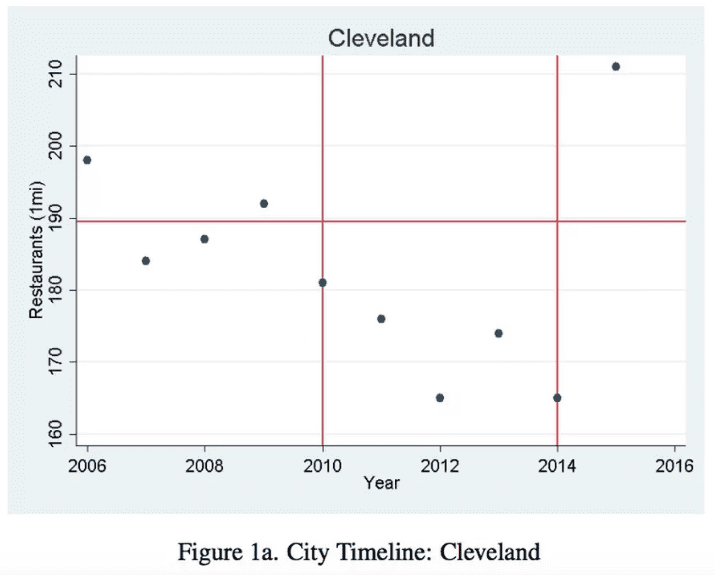
Note: The figure shows the number of restaurants within one mile of the Quicken Loans Arena in Cleveland for each year between 2006 and 2016. LeBron James left Cleveland Cavaliers in 2010 and rejoined in 2014. The horizontal line represents the average number of restaurants within one mile of the stadium before 2010.
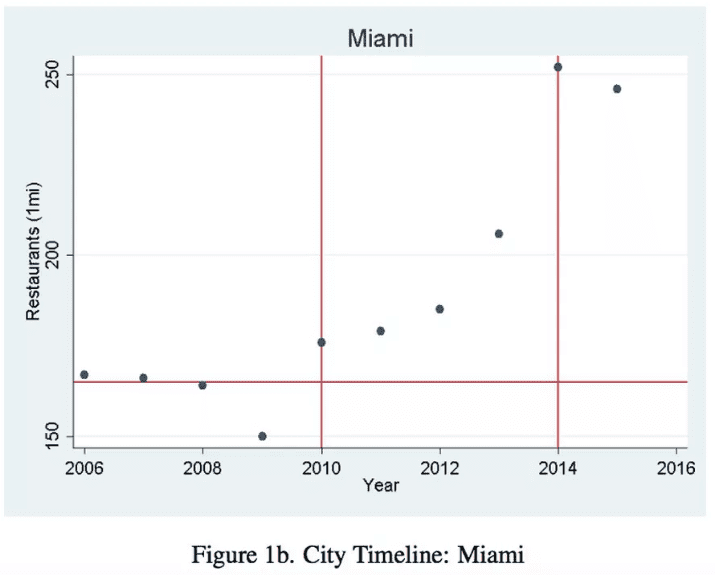
Note: The figure shows the number of restaurants within one mile of the American Airlines Arena in Miami for each year between 2006 and 2016. LeBron James joined Miami Heats in 2010 and left in 2014. The horizontal line represents the average number of restaurants within one mile of the stadium before 2010.
So, based on all this information, what can Los Angeles expect from the James effect? We talked to Jay Tucker, the executive director for the Center of Management of Enterprise Media, Entertainment, & Sports (MEMES) at the UCLA Anderson School of Management, to get his opinion. With more than 20 years of experience in the sector, Tucker was able to offer a detailed look at James and the Los Angeles economy.
The LeBron James Effect In Los Angeles
“Selfishly, I’m excited that he’s coming,” Tucker starts out. “LeBron James is a generational athlete. He’s also a champion of social causes and a shrewd businessman. His arrival will create many opportunities for Los Angeles.” Those opportunities range from easily quantifiable variables such as more local restaurants and bars to less easily definable improvements that could cover everything from better public transport to increased merchandising and new business interests.
In general, Tucker sees Los Angeles as an excellent location for James because of the city itself and the team. LA, being more spread out and without a major city center, could gain even more restaurants, bars, and hangouts than other cities. Part of the reason is because Los Angelenos are already used to driving long distances to get to games at the Staples Center.
At the same time, the Lakers have a solid brand identity that is tied very closely to the city. This will make it even easier for LeBron James to create an impact because Lakers’ fans are already ready and willing to show support for their team. The truth of the matter is that Lakers game attendance is already impressive without James, with James it will only grow.
In addition, Tucker sees many opportunities for LeBron James on the business side. “LeBron has a lot of business interests, and there’s a good possibility that he’ll bring many of those interests here to LA,” Tucker said. “Who knows what the impact could be if LeBron invests in a local talent agency or line of entertainment. There are a ton of opportunities for him to plug into the LA ecosystem and be a part of Silicon Beach, so it will be interesting to see what happens business-wise. It’s really hard to imagine someone as smart, talented, and driven as James sitting back and playing basketball without getting involved in what the rest of LA is doing.”
As for downstream effects that Tucker expects, they’re difficult to quantify but could cover a wide range. For example, studies have shown that successful sports teams improve city moral. Then there’s the fact that as more fans try to attend Lakers games from around the city, there will be a higher demand for public transportation, which could encourage updated infrastructure.
However, Tucker does warn that Los Angeles can’t just sit back and rest on its laurels if the city wants to gain the full economic impact of James. Just as the city already offers packages for individuals looking to visit all the theme parks—Six Flags, Disneyland, Universal Studios, Sea World—the city should also look into creating Lakers’ game packages. This would be a great way to partner with different initiatives around LA and bring in outside visitors.
“With respect to LeBron’s larger business interest, the Chamber of Commerce should get involved as well,” Tucker says. “It would be smart to get the team into meetings to talk about the unique business opportunities in the area.”
What MBA Students Can Learn From LeBron James
Lastly, we asked Tucker what MBA students should take away from the James effect and his overall career. One of the first things he pointed out was James’ positive reputation.
“We live in an era where the media is at your fingertips 24/7,” Tucker says. “And one of the most interesting things about James is that in an environment where anything you do for good or ill can be tweeted out, he’s managed to maintain an image of someone who is socially responsible, who handles himself professionally, and who is a family man. That is something that many people fail to do.”
In addition, Tucker feels that students should pay attention to James’ ability to be multi-faceted. Not only is he deeply invested in his basketball career, but he also has business interests, social interests, and more. James does well on and off the court.
“There’s plenty to learn from his life examples and experience,” Tucker explains. “Some of what can be learned is based on his personal choices, but it’s also about the larger environment he’s in and the scope of opportunities he represents.”
The International Blockchain, Financial Planning, and More – Los Angeles News

We’ve rounded up the biggest stories coming out of the Los Angeles metro this week.
The NBMBAA Scale-Up Pitch Challenge – National Black MBA Association, Inc.
The National Black MBA Association is inviting students to participate in the 2nd annual Scale-Up Pitch Challenge this summer as part of the organization’s broader goal of awarding $2 million in business grants to its membership. The competition gives members a chance to “Make Big Ideas Bigger,” pitching concepts for scaleable startups and connecting them with early stage investors. The winning team will be awarded a $50,000 grand prize at the 40th Annual NBMBAA Conference & Exposition in September
Starting with online submissions, top contestants will be chosen to compete in live pitch events taking place in Atlanta, GA and Los Angeles, CA. The Los Angeles Live Pitch event will take place on August 17, where five finalists will be awarded with complimentary conference registration, hotel and airfare for the finals in Detroit.
Read more about the NBMBAA and the Scale-Up Pitch Challenge here.
$25,000 Grant Funds Student Travel to Personal Financial Planning Conference – Mihaylo Newsroom
Thanks to a $25,000 grant from the McBeth Foundation, students in the Personal Financial Planning program at California State University, Fullerton’s Mihaylo College of Business had the opportunity to visit the Financial Planning Association Annual Conference. The McBeth Foundation supports individuals and groups that are leaving a mark on Southern California communities.
More than 2,000 certified financial planners gathered in Nashville this past October, making the conference the largest gathering of Certified Financial Planners in the world.

David Nanigian, Director of the Mihaylo Personal Financial Planning Program (center) along with students at last year’s event / Photo via business.fullerton.edu
Both student and faculty at the conference commented on the workshops and networking opportunities that have influenced the way they think about financial planning. “I became more aware of the impact young prospective financial advisers, such as myself, will have in educating and planning for various clients,” said Mihaylo finance student Victoria Martinez (’18). “It was useful to have the opportunity to ask professionals what their day-to-day looks like and what to expect out of a financial planning career.”
You can learn more about Mihaylo’s financial planning program and the event here.
Field Study Team Assessing Feasibility of Blockchain Technology as Key to Sustaining Guyana’s Indigenous Communities Earns Inaugural Impact Award – UCLA Anderson Blog
The Impact Alumni AMR Award, established earlier this year, was recently awarded to a team of UCLA Anderson MBAs for the impact made during their Applied Management Research Project, a field study assignment, and capstone of the Anderson full-time MBA.
The team of MBAs, made up of Anderson students’ Miriam Leah Feygenson, Vasiya Krishnan, Anubhav Mishra, Harshita Mishra, and Yuhei Iwasaki, were awarded for their work assessing the feasibility of blockchain technology to solve challenges of the Community Development Plan in Guyana. To celebrate their work, the Impact Alumni AMR Award included a $5,000 prize.
“An important objective for Impact@Anderson is to integrate impact into the core competency of the MBA program, so that all MBA graduates seek out opportunities such as social impact AMRs to be able to positively contribute to society during their time here and beyond” saidd Impact@Anderson executive director Bhavna Sivanand (’14). ”
Learn more about the Impact AMR Award here.
How to Find Your Role with Healthcare Giant McKesson

Since 1833, McKesson has been one of America’s most successful companies, known for its world-class health care systems including medical supplies, pharmaceutical products, medical technology, and care management tools.
Founded in New York City and now headquartered in San Francisco, CA, McKesson is a Fortune Global 500 company with the fifth highest revenue in the U.S. In 2017, the company generated $198.5 billion in revenue through its extensive network infrastructure in the health care industry. Continue reading…
USC Marshall Recognizes Alumni Success, and More – Los Angeles News

We’ve rounded up the top stories coming out of business schools in the Los Angeles metro this week.
Marshall Represents! – USC Marshall Newsroom
Graduates from the Marshall School of Business at USC have reason to celebrate this week, with the release of the Los Angeles Business Journal’s feature, “20 in their 20s,” which heavily features USC Marshall alumni. Nearly half of the list (9 out of 20) have ties to USC Marshall, and several used the feature to call out their most inspiring faculty mentors from the university, such as assistant and associate professors of clinical entrepreneurship, Tommy Knap and Greg Autry.
The list profiles young entrepreneurs already making an impact in their community, though the nature of their work can run the gamut. The organizations and products these entrepreneurs represent include real estate, fitness gear, home furnishings, and more. Laura Hertz, who encountered challenges throughout her career as a result of both age and gender, turned a Marshall class project into an agent for real change with her business gifting company, Gifts for Good.
“I tell [investors] that some of the most disruptive founders in history have been people in their ’20s with no industry knowledge—think Amazon, Airbnb, Uber,” Hertz commented.
Read more about the young Marshall entrepreneurs making an impact here.
Chapman Hosts First Shadow Open Market Committee Conference Towards the West Coast – Chapman University Newsroom
This summer, the Argyros School of Business at Chapman University served as host of the first-ever West Coast conference for the Shadow Open Market Committee. Created in 1973, the SOMC has met annually to discuss issues surrounding the Federal Reserve’s Open Market Committee. For the past 45 years, this conference has gathered distinguished monetary economists from both academia and private institutions in New York or Washington DC. This summer, the organization chose Chapman University as the location for its West Coast debut.
“They are very busy people and famous in the economics and finance world so we are very honored that the SOMC chose Chapman for their first meeting outside of the East Coast,” commented Argyros professor and conference organizer Marc Weidenmier. This year’s conference theme was “The Fed’s Return to Normalcy.”
You can read more about the SOMC conference at Chapman University here.
Their Future is Our Business – UCLA Magazine
This week, UCLA Magazine celebrates the Riordan Programs, now in their 31st year at UCLA’s Anderson School of Management. Beginning in the early 1980s, the Riordan Programs emerged as a way to counter the unrest plaguing the South Los Angeles Area. Now-retired Anderson professor, William Ouchi, believed that getting more people of color involved in business could help inspire a new professional workforce that had the needs of diverse communities in mind. With the help of philanthropist and eventual mayor of Los Angeles, Richard Riordan, Ouchi put his ideas into motion.
The program offers students from low-income backgrounds resources such as college preparation, career guidance and mentorship. Certain programs even help prepare first-generation college students to apply to MBA programs. For students like Denise Gonzalez-Kim, the program opened opportunities that might have never been available otherwise. “I know that my life could have gone a very different way,” she commented on her childhood in South Los Angeles. Today, Gonzalez-Kim is pursuing her MBA at Anderson, after graduating in 2008 with her B.A.
Read more about the Riordan Programs at UCLA Anderson here.
State-of-the-Art Marion Anderson Hall Launching UCLA into the Future
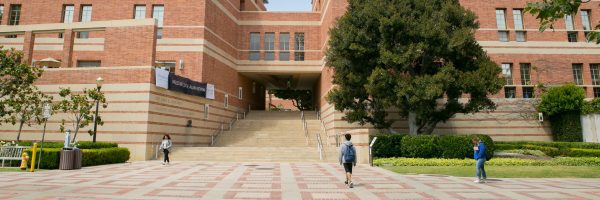
Last fall, UCLA Anderson School of Management broke ground on Marion Anderson Hall, a new state-of-the-art facility designed as a “blueprint for the future” of the school.
Developed in response to the dramatic expansion in programming, student body, and faculty that UCLA Anderson has experienced in the past 23 years, Marion Anderson Hall expands the existing cluster of five interconnected buildings that comprise the UCLA Anderson campus.
As the new primary entrance to the UCLA Anderson campus, the building will serve as both a symbolic and functional gateway to the school. Its design seeks to complement the school’s existing visual identity as it moves into the future, providing a space for students to “think in the next.”
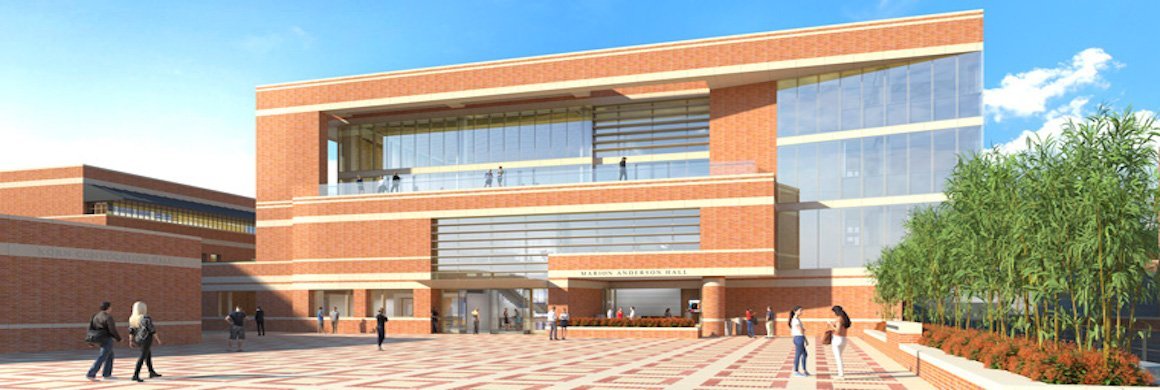
A prototype image of the new Marion Anderson Hall / Photo via UCLA.edu
The building’s design softens harder institutional edges with partial green roofs, access to daylight, and external walkways. It provides small clusters of seating and multi-function nooks and gathering spaces throughout, as well as team-based and active-learning workrooms to facilitate connection and collaboration. The building also exceeds LEED-certification guidelines.
At four stories and 64,000 square feet, Marion Anderson Hall significantly increases the Anderson campus reach. It will use UCLA’s signature four-color blended brick on the exterior and soften the lower roof line with areas of green roofing.
The building will contain acoustically optimized office and classroom spaces with adjustable window glazing. The upper levels will open to a central atrium, which will contain a double-height event space. The exterior will be open to Briskin Plaza on one side and approachable by car on the other.
The architects of the new Marion Anderson Hall are the award-winning PEI Cobb Fried and Partners, a firm known for its environmental sensitivity and its attention to the shaping of the public realm.
UCLA Anderson’s student body has expanded 64 percent since 1995 as it has grown from three degree programs to eight. It now offers a Ph.D., Executive MBA, master’s of financial engineering, master’s of science in business analytics, and two tracks of UCLA-NUS Executive MBA in partnership with the University of Singapore Business School. The new building will accommodate this expansion and provide opportunities for future growth.
The late Marion Anderson, the building’s namesake, is one of UCLA Anderson’s key donors. She and her husband, John Anderson (BS ’40), donated $100 million in May 2015, the largest gift UCLA has ever received. Much of her gift was dedicated to new fellowships and research, but a substantial $40 million was earmarked for the development and construction of a new state-of-the-art building.
As a long-time pillar of leadership and support for UCLA Anderson, Marion Anderson wanted to bring the school into the future. She served on the Board of Advisors and was active in learning about the needs and opportunities of the school. She often attended events and enjoyed getting to know faculty and students. She passed away on May 17, 2017. The building will serve as a reminder of her and her vast legacy of leadership and support.
Sam Tang (MBA ‘87) chose the loft as the area for his naming gift. He imagines the Tang Family Loft as a place to gather, connect, and think big-picture and elevated thoughts.
Marion Anderson Hall reinforces UCLA Anderson’s strategic plan for 2021, “One Anderson,” which involves strengthening connections within the Anderson community, as well as to the outside world. Other goals include increased relevance, more diversity and inclusion, and an elevated social mission.
You can learn more about Marion Anderson Hall here and take a look at the building below.
This article has been edited and republished with permissions from our sister site, Clear Admit.
The California MBA Program Guide
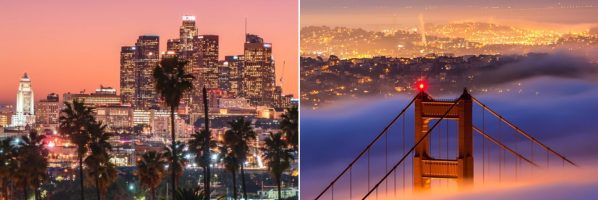
If you’re looking to earn a California MBA, where should you go to school? Should you choose a top MBA program in Los Angeles or San Francisco? Both cities offer beautiful weather, gorgeous beaches, and world-class business education, but is one location better than the other?
Los Angeles vs. San Francisco
To get started, it’s necessary to compare the cost of living in Los Angeles and San Francisco. According to Numbeo, the world’s largest database containing user contributed data about cities, San Francisco is far and away the more expensive place to live. You would need $7,748.24 in San Francisco, CA to afford the same lifestyle that you can have for $5,700 in Los Angeles. That’s just over $2,000 more per month needed to live in San Francisco, and here’s how that’s broken down.
- Consumer Prices:98 percent higher in San Francisco
- Rent Prices: 51 percent higher in San Francisco
- Restaurant Prices: 62 percent higher in San Francisco
- Groceries Cost: 8 percent higher in San Francisco
- Local Purchasing Power: 77 percent higher in San Francisco
Right off the bat, it’s obvious that the cost of rent (real estate) is what will eat up most of your paycheck in San Francisco, but is that offset by anything? Here are the other things to consider when choosing between San Francisco and Los Angeles.
- Industries
- Los Angeles is ranked top in the country for manufacturing with over 500,000 workers in the industry. Other top industries include banking and finance (more than 100 foreign and domestic banks), entertainment, and tourism.
- San Francisco, on the other hand, is known as Silicon Valley (with San Jose) for its technology companies and startups (Intel, Apple, Genentech, Google, Uber, and Twitter). It’s also a great city for finance, global business, medical science, biotechnology, tourism, and fashion apparel (home of the Levi Strauss & Co headquarters).
- Economic Development: According to the Center for Jobs, San Francisco far and away outperforms Los Angeles in terms of economic growth and development with the Bay Area growing year-over-year while LA has struggled with almost consistent decreases.

- Top Companies: California is home to 53 Fortune 500 companies, second only to NYC. And more of those companies are located in the Bay Area compared to Los Angeles. San Francisco is home to Apple (3), McKesson (5), Chevron (19), and Wells Fargo (25). While Los Angeles is home to Aecom (161), CBRE (214), and Reliance Steel & Aluminum Co (320).
Los Angeles vs San Francisco MBA Programs
The next step is to compare the top three MBA programs in each city. In particular, we wanted to take a look at the tuition rates (two years), GMAT averages, and post-graduation salaries at each program in each city to get a well-rounded picture.
There are a few things to note right away.
- San Francisco is home to more highly ranked MBA programs with two ranking in the top ten on every list. However, it’s important to note that both cities have programs that rank well and are considered top tier schools.
- The average tuition in each city is fairly even. However, the most expensive ($137,00) and the most affordable ($77,000) schools are located in San Francisco, whereas Los Angeles is more even regarding tuition across the board.
- You’ll need a better GMAT score to go to a school in San Francisco, and that GMAT score translates into a higher salary after graduation. San Francisco graduates earn about $11,000 more per year compared to their LA counterparts.
Here’s how it all breaks down per school.
Top 3 Los Angeles MBA Programs
Anderson School of Management – UCLA
The UCLA Anderson School of Management offers a full-time MBA, a part-time MBA, an Executive MBA, and a UCLA-NUS Global MBA (Asia Pacific) program. It’s considered one of the top business schools in the world, ranking 6th in the Economist, 15th in Forbes, 16th in the U.S. News & World Report, and 25th in Financial Times.
- Tuition Rates (two years): $117,176
- GMAT Averages: 719
- Post-Grad Salaries (Mean): $119,964
Marshall School of Business – USC
The Marshall School of Business at USC offers a full-time MBA program, a part-time MBA, an Executive MBA, and IBEAR (International Business Education and Research) MBA, and an Online MBA program. The school’s full-time MBA program is ranked: 20th in the U.S. News & World Report, 33rd in Forbes, 59th in Financial Times, and 65th in the Economist.
- Tuition Rates (two years): $116,361
- GMAT Averages: 703
- Post-Grad Salaries (Mean): $115,309
The Paul Merage School of Business – University of California, Irvine
The Paul Merage School of Business has both a full-time MBA program as well as a part-time fully-employed MBA program. In addition, the school offers an Executive MBA and a Health Care Executive MBA program. The business school is ranked highly across multiple rankings including 41st in Forbes, 42nd in the U.S. News & World Report, 56th in the Economist, 64th in Financial Times.
- Tuition Rates (two years): $87,661
- GMAT Averages: 652
- Post-Grad Salaries (Mean): $97,808
Top 3 San Francisco MBA Programs
Haas School of Business – UC Berkeley
The Haas School of Business offers a full-time MBA, part-time MBA, and Executive MBA program. Haas is ranked as one of the top business school’s in the world ranking in the top ten on every list: 7th overall in U.S. News & World Report and 7th overall in the Economist, as well as 9th overall in Forbes, and 10th overall in the Financial Times.
- Tuition Rates (two years): $117,444
- GMAT Averages: 725
- Post-Grad Salaries (Mean): $125,573
Stanford University Graduate School of Business
The Stanford University Graduate School of Business offers only a full-time MBA program, but it’s one of, if not the top two-year program in the world. When looking at how Stanford GSB stacks up to the competition, the rankings speak for themselves with all in the top ten and most in the top five, including: 1st overall in the Financial Times, 2nd overall in Forbes, 4th in the U.S. News & World Report, and 9th in the Economist.
- Tuition Rates (two years): $137,736
- GMAT Averages: 733
- Post-Grad Salaries (Mean): $144,455
UC Davis Graduate School of Management
At the UC Davis Graduate School of Management, MBA applicants can apply to the full-time MBA or the part-time MBA program. Once again, UC Davis is one of the top schools in the world, ranking 37th in the U.S. News & World Report, 63rd in Forbes, and 67th in the Economist.
- Tuition Rates (two years): $77,698
- GMAT Averages: 669
- Post-Grad Salaries (Mean): $97,695
California MBA Breakdown in Charts
When breaking down the data between MBA programs in Los Angeles and San Francisco, here’s what it looks like
California MBA Tuition (Los Angeles vs. San Francisco)
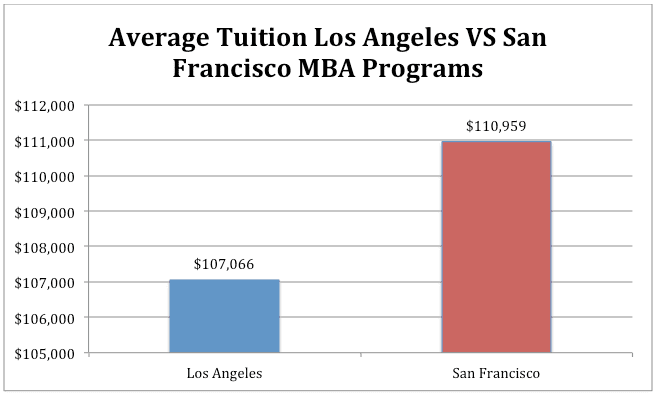
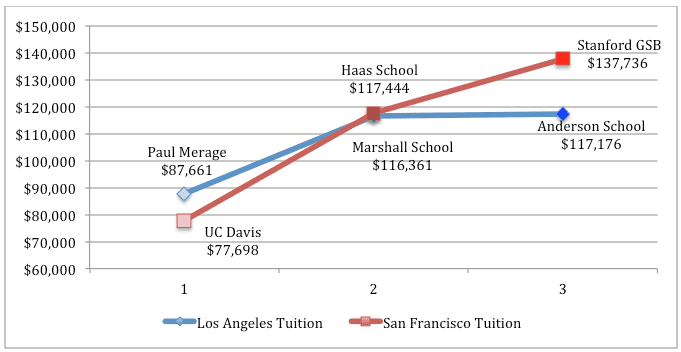
California MBA GMAT Averages
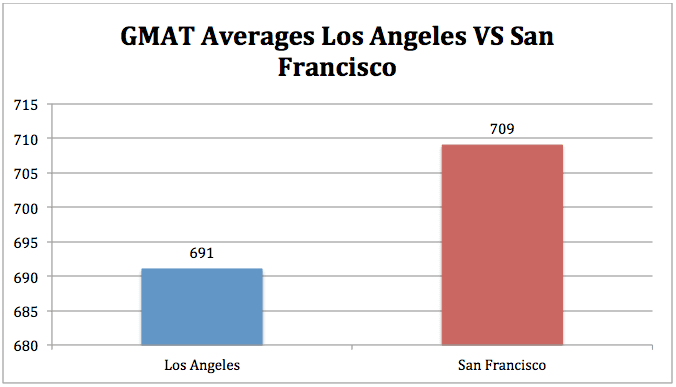
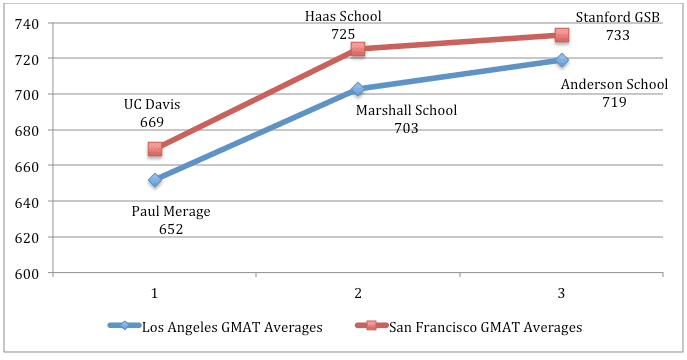
California MBA Post-Graduation Salaries
